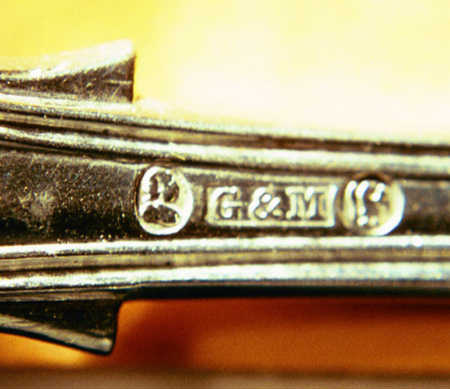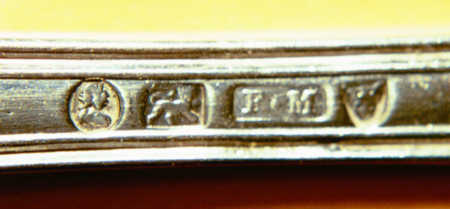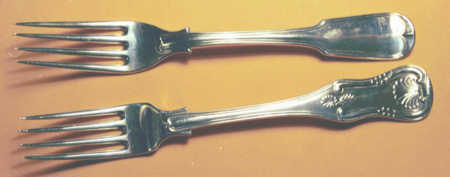|
A GLOSSARY of MILLED BANDS
|
|
| How to Post Photos |
REGISTER (click here)
|
|
A GLOSSARY of MILLED BANDS
|
|
| How to Post Photos |
REGISTER (click here)
|

|
 SMP Silver Salon Forums SMP Silver Salon Forums
  American Silver before sterling American Silver before sterling
  Help with ID. Help with ID.
|
| next newest topic | next oldest topic |
| Author | Topic: Help with ID. |
|
ksrabe@earthlink.net Posts: 14 |
  
Can anyone ID this mark found on a 13", Kings pattern Ladle which was identified 20 years ago by an appraiser as being 1720"s English, but I feel sure is 1820's American by either Frederick Marquand or William Forbes. Currier show a very similar mark "unidentified" on page 46 and by Forbes on page 54. I could not find the mark in any other generic American Marks books. Any suggestions? IP: Logged |
|
wev Moderator Posts: 4121 |
  
Not an appraiser you still deal with, I hope. Certainly American, but I can not make out the maker's mark well enough to give a guess. Does it look like: William Garret Forbes or: IP: Logged |
|
ksrabe@earthlink.net Posts: 14 |
  
No I have no association with that appraiser. The makers mark which is hard to read in the photo is definitely "FM" which I ascertained by using a loop. So I guess this is Frederick Maquand's work. It appears Forbes name was sometimes also used with Maquand's mark and pseudo hallmarks which is why I was a little confused.( see Currier's page 93.) Does the book which is sold on this site contain these marks? .What reference is the best for American coin besides buying the books for each state? Here is a photo of the ladle. Karen IP: Logged |
|
ksrabe@earthlink.net Posts: 14 |
  
I just found this Christies, 1/16/1998 , Lot 61,auction record which anwsers all of my questions. It appears that Marquand used date letters only while working in Savannah. Yes !!!!Here is the record for everyones benifit. The ladle sold for $2300,00 A SILVER SOUP LADLE
IP: Logged |
|
labarbedor Posts: 353 |
  
I am sure not OK with that assumption. I don't know where they got that. The D in the psuedo hallmarks is not a date letter it is a reference to "dollar" or coin silver. Like P for premium, and other marks it was just a way of saying the item was silver when formal marking was not required. Psuedo hallmarks in general were more a Northern trend than a Southern one. IP: Logged |
|
Brent Posts: 1507 |
  
I would tend to agree with labarbedor. The three marks on the right most likely comprise a northern manufacturer's trademark. These pseudo-hallmarks were once thought to be simply imitations of English hallmarks, but recent research has shown that many particular combinations were in fact trademarks of manufacturers. Some even appear on the maufacturer's trade cards. Brent IP: Logged |
|
wev Moderator Posts: 4121 |
  
I agree completely; any assumption of date or maker based on pseudohallmarks is a pipe dream. The attribution of the ladle to Marquand is perfectly reasonable -- in addition to the maker's mark, he seemed to have had a real affiniity for the King's pattern. But remember as well that he spent at least a decade working on and off in New York City where such marks were used by scores of makers, both wholesale and retail. For every instance of an attribution or dating based on pseudohallmarks, I can probably find at least one example that contradicts it. And keep in mind, too, that Christie's raison d'etre is to sell goods to the highest bidder. IP: Logged |
|
ksrabe@earthlink.net Posts: 14 |
  
I have a copy of the Antiques magazine article, Savannah Silver and Silversmiths, by James A. Williams, The Magazine Antiques, March 1967, pages 347-349 which says that Marquand, originally from New York, worked for a brief period in Savannah, Georgia with his cousin Penfield from 1821-1826 before returning to New York. It states: “He was the only Savannah silversmith to use pseudo hallmarks. They consist of lion rampant facing right (the London ones face left), a profile like the English sovereign’s head, and a series of date letters-C through G, for the years 1821-1825. These appear with his own mark of F.M. or F. Marquand.” This is exactly what is on this ladle. IP: Logged |
|
ksrabe@earthlink.net Posts: 14 |
  
I just saw your post wev. It really doesn't matter to me if it is an exact date, what really matters is that is by Marquand. I can live with circa 1820's. Thanks for all of your comments. IP: Logged |
|
wev Moderator Posts: 4121 |
  
I just did a quick run through my collection database. I found 22 makers that used a bust/lion/letter series of pseudohallmarks with letters ranging from D to S. Of those 13 worked in New York City at some time in their career and all but one during the same years Marquand was active in Georgia and New York. Mr Williams' theory is interesting, but unless he has seen every piece so marked by Marquand and has verifiable evidence as to its origin and date -- and has found none that contradict it -- his theory is just that, an interesting theory. Personally, I find it, like all others dealing with pseudohallmarks, very hard to believe. But this, as you say, is beside the point: you have a lovely and desirable piece of silver. [This message has been edited by wev (edited 02-09-2003).] IP: Logged |
|
labarbedor Posts: 353 |
  
All this discussion caused by an appraiser who probably thinks all Gorham silver was made in Birmingham. I don't think it makes any difference what date, but Savannah..NY question makes a difference. Of course the easy answer is the same as that Texas question. I buy NY, I sell Savannah. I see those letters as representing different ways of saying coin. C-Coin, D-dollar, E-extra, F-fine, G-good. If they are date letters why don't you ever see A,B,I,J...X,Y.Z except for P-premium. S-siver I will discard this opinion if someone comes up with J-junk, or K-krap. I wonder if you could list the letters found in the 22 in the data base. IP: Logged |
|
ksrabe@earthlink.net Posts: 14 |
  
I will see if I can find out how credible Mr. Williams was back in the 60's. Is there anything published that supports labarbedor's thoughts when he says "I see those letters as representing different ways of saying coin. C-Coin, D-dollar, E-extra, F-fine, G-good."? I have run several auction records and a few retail sales on Marquand and it doesn't seem to matter if it advertized "New York" or "Savannah", they all bring a good price. Of course, I realize that there has been a frenzy over Southern Silver. I lived in Charleston for several years and there are many in the South sho would pay a premium if it where touted as being Southern. We know that many silversmiths worked in several places,just like the Furniture makers. I too am interested to know what the 22 letters in the database are. IP: Logged |
|
wev Moderator Posts: 4121 |
  
The 22 letters break down as follows: C - 2 D - 14 G - 3 H - 1 S - 1 W - 1 I also did a quick run through Darling's New York Silversmiths and found IP: Logged |
|
Fitzhugh Posts: 136 |
  
If the letters in the hallmarks do NOT signify dates, but rather manufactures or quality marks, then we need to assess why only 5 are known on Marquand silver, and they in consecutive order, correlating with his stay in Savannah. It appears to be more than a coincidence. I agree completely with labarbedor, that generally these letters denote quality/purity, but we generally see only ONE such letter utilized, and not a series of differing letters from the same retailer. "P" and "D" are generally recognized as standard marks for Premium or Dollar, and do surface on Souther retailed pieces beginning I assume in the 1820's, based upon examples I've encountered. I'm not sure I can recollect a "C" mark in such a sequence of pseudo's, but I guess it exists. Surely yankee manufacturers didn't alter their trademarks if these represent such?? I would speculate that a "school" of NY smiths utilized these pseudo-groupings, with some letters signifying export, some quality standard, others a particular customer, and some dates, as with Marquand. As most retailers bought on credit, it makes sense that his inventory from the manufacture in NY be so marked over the course of his stay in Georgia. IP: Logged |
|
wev Moderator Posts: 4121 |
  
What evidence do we have that all the pieces marked with these pseudohallmarks were from the Savannah period? What evidence that the letters were in fact used in consecutive order? Short of a document to the fact, or a survey verifying every item and its date of making, it would seem to be a nice theory, but more likely coincidence or wishful thinking. IP: Logged |
|
labarbedor Posts: 353 |
  
I've got one last question concerning these five letters used as date marks. Why? It seems a long way to go considering a silversmith has very little reason to care about what year he made a piece in. It would seem far more likely that he had some other reason, maybe they are jouneymen's marks, or some other coding system. I believe in Occam's razor. An unusual theory needs unusually strong proof. IP: Logged |
|
Richard Kurtzman Moderator Posts: 768 |
  
I hope I am not throwing more fuel on this fire, but I am thoroughly confused by all this. I have two Basket Of Flowers with Shell Back serving spoons. Both have this mark. Savannah, New York, The Moon....? IP: Logged |
|
Kate611 unregistered |
 
Just to add a little confusion to this. I looked through my files. Every mark I have identified to Fredrick Marquand (either F.Marquand or F.M.) has a head profile similar to Richard's mark. On some the profile is first, then the lion, on others this is reversed, but the head is always upright and with distinct features. I have the three marks on Karen's spoon (including the sideways head) with an number of different names including John A. Cole, P. Miller (this is in Belden's book) L. Corey, Freeman & Wallin, B.G (Baldwin & Gardiner), and Hayes & Robbins. Also, I have read that Marquand used the lettering system for 1821-1826, but every one that I have seen with a letter, it has been G (including in Belden's example), so if it is true, 1826 must have been a very prolific year. Katherine Rauch IP: Logged |
|
kate611 unregistered |
 
Opps. I should have looked a little bit farther. I do have three examples attributed to Frederick Marquand with the sideways head. All of these have the letter D. Two are F.M. and one does not have the periods. Katherine Rauch IP: Logged |
|
ahwt Posts: 2334 |
  
   Not sure about how to post pictures, but I think the above will go to some pictures of some Fiddle Thread forks with the G&M marks for Gale and Moseley. These forks have a man’s head and an eagle on either side of the G&M marks. The man’s head on the Gale and Moseley forks appear identical to a man’s head marked on some King’s pattern forks that I have. These forks are marked with the F pellet M mark for Frederick Marquand. While the heads seem identical, the punch outline is more oval on one. The Frederick Marquand forks do not have a letter as in your example, however they do have the lion passant facing right and a crowned leopard. The crowned leopard is interesting in that it is similar to the English version, but the leopard’s crown is twice as big as the English version and gives a humorous look to the mark. The similar shoulders on these forks may indicate that Gale did both of them. Various marks found on Marquand silver are discussed in an article by Edward Pattillo in the November/December 2000 issue of Silver Magazine. Mr. Pattillo gives examples of other “southern silver” where letters are used with the lion passant and heads of various types and provides some evidence that William Gale may be the actual manufacturer of much of this silver. I love your forum. Thanks for all your efforts. IP: Logged |
All times are ET | next newest topic | next oldest topic |
  |
|
Ultimate Bulletin Board 5.46a
|
1. Public Silver Forums (open Free membership) - anyone with a valid e-mail address may register. Once you have received your Silver Salon Forum password, and then if you abide by the Silver Salon Forum Guidelines, you may start a thread or post a reply in the New Members' Forum. New Members who show a continued willingness to participate, to completely read and abide by the Guidelines will be allowed to post to the Member Public Forums. 2. Private Silver Salon Forums (invitational or $ donation membership) - The Private Silver Salon Forums require registration and special authorization to view, search, start a thread or to post a reply. Special authorization can be obtained in one of several ways: by Invitation; Annual $ Donation; or via Special Limited Membership. For more details click here (under development). 3. Administrative/Special Private Forums (special membership required) - These forums are reserved for special subjects or administrative discussion. These forums are not open to the public and require special authorization to view or post. |
|
copyright © 1993 - 2022
SM Publications
All Rights Reserved. Legal & Privacy Notices |